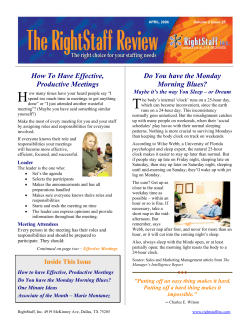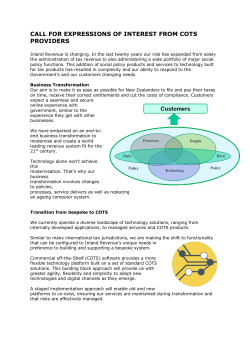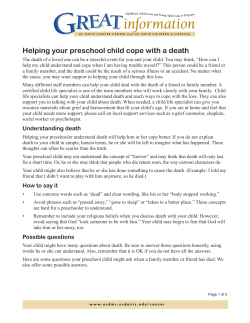
Safe sleep and rest times INTRODUCTION EXAMPLE POLICY
EXAMPLE POLICY Safe sleep and rest times INTRODUCTION All children have individual sleep and rest requirements. Children need a comfortable relaxing environment to enable their bodies to rest. This environment must be safe and well supervised to ensure children are safe, healthy and secure in their environment. GOALS - What are we going to do? The education and care service will ensure that all children have appropriate opportunities to sleep, rest and relax in accordance with their individual needs. The education and care service will provide beds and cots that comply with Australian Standards. The risk of Sudden Infant Death Syndrome (SIDS) will be minimised by following practices and guidelines set out by health authorities. • Educators will: • Consult with families about children’s sleep and rest needs. Educators will be sensitive to each child’s needs so that sleep and rest times are a positive experience. • Ensure that beds/mattresses are clean and in good repair. Beds and mattresses will be wiped over with warm water and neutral detergent or vinegar between each use. • Ensure that bed linen is clean and in good repair. Bed linen is for use by an individual child and will be washed before use by another child. • Arrange children’s beds and cots to allow easy access for children and staff. • Create a relaxing atmosphere for resting children by playing relaxation music, reading stories, cultural reflection, turning off lights and ensuring children are comfortably clothed. The environment should be tranquil and calm for both educators and children. Educators will sit near resting children and support them by encouraging them to relax and listen to music or stories. • Remember that children do not need to be “patted” to sleep. By providing a quiet, tranquil environment, children will choose to sleep if their body needs it. • Encourage children to rest their bodies and minds for 20-30 minutes. If children are awake after this time, they will be provided quiet activities for the duration of rest time. STRATEGIES - How will it be done? The Approved Provider will: • “Take reasonable steps to ensure that the needs for sleep and rest of children being educated and cared for by the service are met, having regard to the ages, development stages and individual needs of the children.” (Regulation 81.) • Ensure there are adequate numbers of cots and bedding available to children that meet Australian Standards. • Ensure that all cots meet AS/NZS 2172. • Ensure that areas for sleep and rest are well ventilated and have natural lighting. • Ensure that supervision windows will be kept clear to ensure safe supervision of sleeping children. The Nominated Supervisor will: • “Take reasonable steps to ensure that the needs for sleep and rest of children being educated and cared for by the service are met, having regard to the ages, development stages and individual needs of the children.” (Regulation 81.) Policy Review Date: July 2013 Maintain up to date knowledge regarding safe sleeping practice and communicate this information to educators and families. 1/3 Safe sleep and rest times • Maintain adequate supervision and maintain educator ratios throughout the rest period. • Assess each child’s circumstances and current health to determine whether higher supervision levels and checks may be required. • Communicate with families about their child’s sleeping or rest times and the service policy regarding sleep and rest times. • Respect family preferences regarding sleep and rest and consider these daily while ensuring children feel safe and secure in the environment. Conversations with families may be necessary to remind families that children will neither be forced to sleep nor prevented from sleeping. Sleep and rest patterns will be recorded daily for families. • Encourage children to dress appropriately for the room temperature when resting or sleeping. Lighter clothing is preferable, with children encouraged to remove shoes, jumpers, jackets and bulky clothing. The room temperature will be considered to ensure maximum comfort for the children. Children in Cots Educators will: • Give bottle-fed children their bottles before going to bed. Children will not be put in cots or in beds with bottles as per the Dental health policy. • Ensure that cot rooms and sleep rooms must have operational baby monitors on at all times. • Observe children at 10-15 minute intervals while they sleep in these rooms. Educators must go into the rooms and physically see babies breathing. The educator will then officially record this. • Ensure that cot mattresses are clean, firm and the correct size for the cot frame. • Make up cots to comply with SIDS safe sleeping guidelines. Babies will be placed on their backs to sleep, but they will be able to find their own sleeping position. No loose bedding is to be available to the child. Bed linens will be firmly tucked under the mattress to reduce the risk of a child covering their face. Put the baby’s feet at the bottom of the cot so the baby cannot slip down under the covers. Tuck the baby in securely so bed linen is not loose. No doonas, duvets, pillows or cot bumpers will be placed in cots. 2/3 • Encourage the use of sleeping bags for babies. If they have fitted neck and armholes there is no risk for the child’s face being covered. • Securely lock cots sides into place to ensure children’s safety. • Turn off wall-mounted heaters before children use the room for sleeping. Cot rooms will be air conditioned and maintained at an appropriate temperature. • Be aware of manual handling practices when lifting babies in and out of cots. • Participate in staff development about safe sleeping practices. The education and care service will access the SIDS & Kids resource kit and provide information to families on safe sleeping practices. EVALUATION Communications with families are maintained to encourage a consistent approach in responding appropriately and respectfully to children’s sleep and rest needs. Safe sleeping practices are followed to minimise the risk of harm to children and babies. Policy Review Date: July 2013 Safe sleep and rest times * This sample policy is for information purpose only. You are welcome to use this material, with acknowledgement to Community Child Care Co-operative (NSW). Statutory Legislation & Considerations • Education and Care Services National Regulations • Guidelines for SIDS and Kids Safe Sleeping in Childcare Facilities • Australian Consumer Law 2011 - Australian Competition and Consumer Commission. • The NSW Work Health and Safety Act 2011 & the NSW Work Health and Safety Regulation 2011 Sources • Guide to the National Quality Standard (3) ACECQA (2011) • Guide to the Education and Care Services National Law and the Education and Care Services National Regulations • SIDS & Kids Safe Sleeping Kit – www.sidsandkids.org • Standards Australia – www.standards.org.au • The Children’s Hospital at Westmead – Safety factsheet – Cots and Cot Mattresses, http://kidshealth.schn.health.nsw.gov.au/sites/ kidshealth.schn.health.nsw.gov.au/files/safetyfactsheets/cots-and-cot-mattresses.pdf • Australian Competition and Consumer Commission (ACCC) – www.accc.gov.au - Cot safety PDF Links to other policies • Clothing and Footwear • Guidelines & Agreements for Enrolment • Dental Health • Supervision • Family Communication and Participation • Enrolment and Orientation • Interactions with Children • Clean and Maintain the Environment »» Links to Education and Care Services National Regulations: 81,103, 105, 110, 115 »» Links to National Quality Standards/Elements: 2.1.2, 2.3.1, 2.3.2, 3.1 Policy Review Date: July 2013 3/3
© Copyright 2025





















